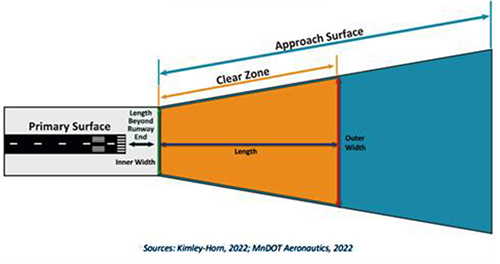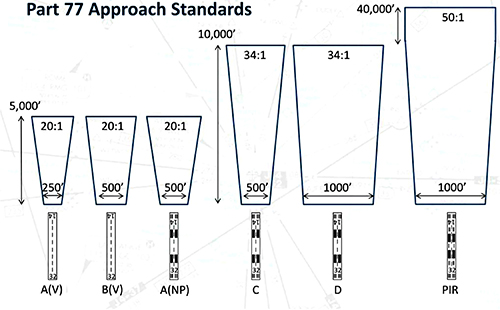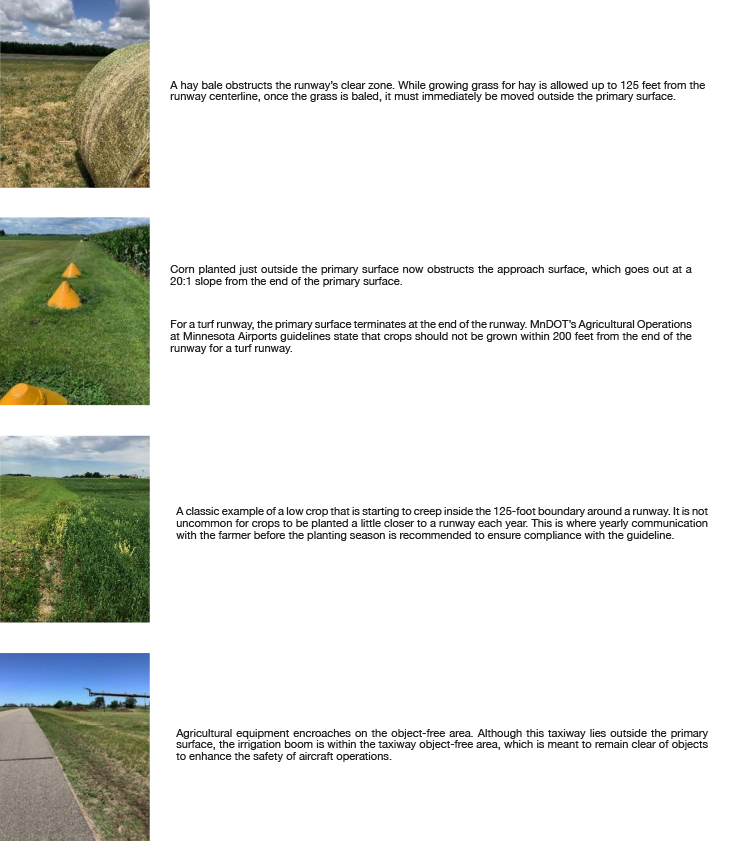by Jared Wedel
MnDOT Aeronautics Airport Coordinator – North Region
Published in Midwest Flyer Magazine April/May 2024 Digital Issue
One of the hardest things to tell farmers is that they can’t plant crops on perfectly good tillable land. Yet, that can happen when crops encroach on the land surrounding an airport.
As part of MnDOT’s 5010 airport inspections, MnDOT Aeronautics inspectors identify any objects obstructing the navigable airspace surrounding an airport as defined in FAA Regulations Part 77. Typically, these obstructions are trees, brush, the occasional fence – and sometimes even crops planted inside the clear zone surrounding the runways. Depending on the airport, the land inside the clear zone can either be owned by the airport and leased out to a farmer or privately owned.
To understand what’s required by Part 77, we must first understand how FAA Part 77 defines the imaginary surfaces around the runway that must be kept clear.
First is the primary surface. According to 14 CFR 77.19 – Civil airport imaginary surfaces, the primary surface is centered on the runway. The length of the primary surface runs the length of the runway for turf runways and extends 200 feet off each end for paved runways. The width of the primary surface varies as well. The minimum width is 250 feet centered on the runway (125 feet on either side of the centerline). If either end of the runway has an instrument approach, the primary surface is 500 feet wide. It is further widened to 1,000 feet for runways with a precision approach or non-precision approaches with visibility minimums less than 3/4 of a mile. The only things allowed inside the primary surface are objects required for airport operations, such as airport signs and runway lights.

The approach surface is the second imaginary surface defined and regulated under 14 CFR 77.19 – Civil airport imaginary surfaces. The approach surface is meant to keep a clear flight path in the airspace used for landings and takeoffs. Approach surfaces extend uniformly upward and outward from the primary surface at a slope of 20:1, 34:1, or 50:1, depending on the type of approach for the runway.

Primary surfaces are clear zones that surround any runway. Above shows the basic parameters of the primary surface for a paved runway. The primary surface varies depending on the runway and type of approach.
The approach surface is the second imaginary surface defined and regulated under 14 CFR 77.19 – Civil airport imaginary surfaces. The approach surface is meant to keep a clear flight path in the airspace used for landings and takeoffs. Approach surfaces extend uniformly upward and outward from the primary surface at a slope of 20:1, 34:1, or 50:1, depending on the type of approach for the runway.
Guidelines help communicate about clear zones
To help make things easier when communicating with farmers or landowners, MnDOT has come out with guidance to help clarify the boundaries to be maintained around an airport to maintain a safe and unobstructed airspace. Airport managers are encouraged to use these guidelines to talk with local farmers prior to each planting season. Some of the policies include:
• Within the primary surface, there should be no farming of any kind within 125 feet of the runway centerline. This area should be kept as a grassy clear zone maintained by the airport. This area provides a clear zone for aircraft that depart the runway and is meant to improve safety, minimize damage, and allow emergency services to access aircraft quickly. From 125 feet to the outer boundary of the primary surface, low crops such as soybeans, peas, and cereal grains like alfalfa, wheat, barley, and oats with mature heights of less than four feet can be planted. Hay is another suitable crop that can be grown in this area, but as the hay is baled, the bales must be moved immediately to outside the primary surface to prevent obstruction. If the runway has an ILS approach, that 125 feet gets pushed out to 250 feet from the centerline to avoid interference with the localizer signal.
• For the approach surface, crops should be planted no closer than 200 feet from the end of the runway for a turf runway and 400 feet for a smaller paved runway. For runways with non-precision approaches that can land aircraft over 12,500 pounds, that number is 600 feet. For runways with precision approaches, no crops can be planted within 700 feet of the end of the runway.
• There are also clearances around airport navigational aids like ILS antennas, VORs, and automated weather stations.
• Illustrations in MnDOTs Agricultural Guidelines document, help and communicate operations allowed at Minnesota airports.
Following these guidelines improves safety for everyone and requires constant attention and monitoring by airport managers. For example, drainage concerns may arise from cropland surrounding airports. Wildlife often accompanies crops and must be addressed. Operating large farm equipment around the airport also requires effective communication between the farmer and the airport, and if necessary, a NOTAM must be issued, notifying pilots of their presence.
When it comes down to it, care must be taken to effectively communicate with neighboring farmers, landowners, and those operating farmland surrounding airports, to ensure that farming operations do not interfere with aircraft operations.
MnDOT Agricultural Guidelines can be found on the MnDOT Aeronautics website under the Airports tab, then scroll down to Airport Operations – 5010 Airport Inspections or at mndot.gov/aero/operations/documents/airportagriculturalguidelines.pdf
Below are some examples of agricultural operations that commonly obstruct airport clear zones
